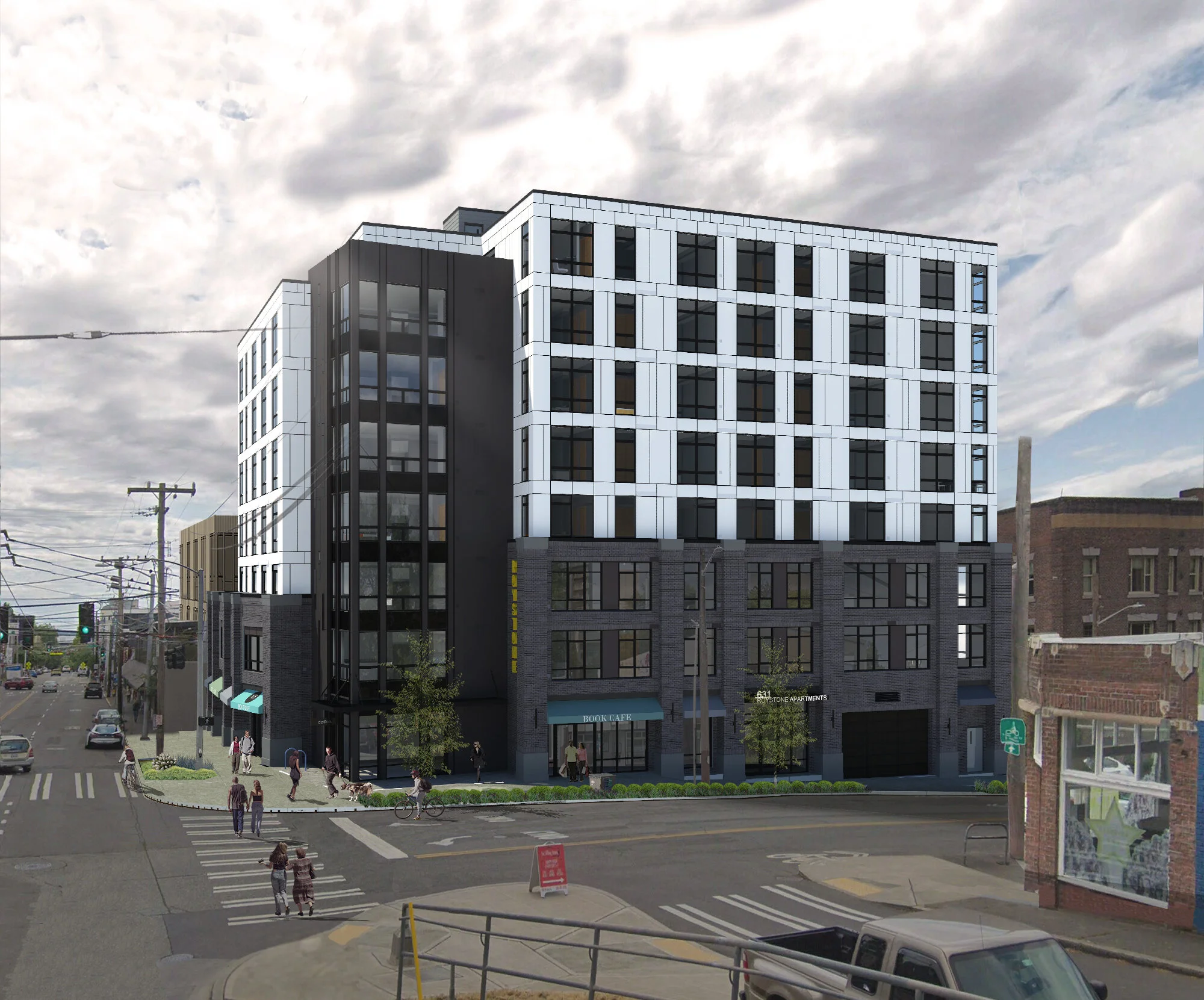Roystone Apartments: A Case Study from EPRO Services, Inc.
JMA recently collaborated with EPRO Services Inc. to protect a future apartment building from water damage and contaminant vapor intrusion.
The Project
Last year Seattle based multi-family real estate developer Vibrant Cites started construction on the Roystone Apartments, an 8-story mixed use apartment building designed by JMA in Seattle’s rapidly developing Lower Queen Anne neighborhood. The 74,096 SF building will include roof decks and ample amenities to support the added residents to the local community. It will also have 93 units with ground floor retail and a one-story below grade parking garage. The project has required a unique collaboration between all parties involved due to the site’s previous history.
The History
A Texaco gas station operated on the Roystone site from 1923 to 1993. In 1986 the Washington Department of Ecology responded to complaints of gasoline odors at the adjacent apartment complex. An investigation conducted from 1986 to 1990 revealed the gas station as the source.
“Many dense urban locations struggle with the dirty legacy left behind by the corner gas station. Failed antiquated underground storage tanks (UST), some originally buried as far back as the 1920’s and 30’s, leak diesel and gasoline into adjacent soils causing an underground plume of contaminated soil and groundwater. With rising demand for more urban residential development, effective contaminant mitigation methods must be employed to repurpose these properties,” said JMA Principal Robin Murphy.
Two wells were installed to remove petroleum from groundwater, seven underground storage tanks were removed, and a soil vapor extraction and groundwater recovery system was put in place. Texaco’s successor, Chevron Environmental Management Company (CEMC), upgraded and operated the system from 2003 to 2008 under Ecology’s Voluntary Cleanup Program.
The Cleanup
Pavilion Construction, Roystone’s general contractor, began site cleanup in March 2020. In addition to the seven USTs already removed from the site, an additional three USTs containing diesel and waste oil were removed.
“In total, approximately 16,235 tons of petroleum-contaminated soil, 62 tons of soil containing solvents, and 1.47 tons of soil containing waste oil were removed and disposed of property,” said Site Superintendent Roger Woods from Pavilion Construction. “Site logistics and careful planning was essential for the proper execution of these site contaminant cleanup efforts.”
All soil containing concentrations of contaminants above allowable MTCA soil cleanup levels have been removed from within the Property boundaries.
Considering the site is also shallow groundwater, the project design team, BEE Consulting, was tasked with the selection of an appropriate waterproofing and contaminant vapor intrusion system.
“After careful consideration and consultation with our design team partners, we approved EPRO’s PreTak waterproofing and contaminant vapor intrusion membrane for this project,” said BEE Project Manager Patrick McMahon. “EPRO’s Pre-Tak 48 mil thick high-density polyethylene, fully adhered pre-applied membrane is ideal for waterproofing protection in hydrostatic conditions while offering robust chemical contaminant vapor barrier performance. We were also comfortable with EPRO’s history of performance and experience with projects of similar scope and complexity.”
What is EPRO Pretak?
EPRO PreTak is an entire below grade building envelope solution. It has provided an effective waterproofing and contaminant vapor barrier membrane necessary to rewrite the legacy of this Seattle corner gas station. Thanks to the membrane solution, the project will safely and economically serve the community for many years to come.
How was it used?
EPRO PreTak membrane was installed at all under slab locations directly over compacted fill and vertically against the soldier pile lagging support of excavation (blindside waterproofing). The blind-side assembly consisted of EPRO e.drain drainage composite with embedded filter fabric against soldier pile lagging with PreTak mechanically fastened to the lagging. Sheet metal field fabricated “box outs” detailed with PreTak membrane were installed over all tie-backs.
To accommodate the use of structural shotcrete for the below grade foundation walls, all seams were reinforced with an additional application of four-inch wide PreTak PreTape.
After concrete is applied to the surface of PreTak, the solution’s specially formulated pressure sensitive adhesive integrally adheres the surface of the membrane to the fresh concrete with over 20 pounds per inch of adhesive bond strength. This fully adhered waterproofing and contaminant vapor intrusion barrier system effectively eliminates the potential for lateral water migration between the installed membrane and concrete substrate while effectively protecting the structure from residual subsurface contamination.
“Not only was EPRO PreTak a solid performance choice for this project, it was the most cost competitive option that we evaluated,” said Woods. “EPRO’s ap-proved applicator Emerald City Waterproofing was able to provide cost savings to a competing bidder with a system claiming similar performance.”
Click here to download the case study from EPRO Services, Inc.
The History of Queen Anne Avenue
Roystone sits on Queen Anne Avenue which used to host Seattle’s counterbalance trolley in the early 20th century. Counterbalance streetcars operated with tunnels, right below the tracks, containing heavy miniature rail cars that acted as counterweights to the electric trolleys above. When the trolleys were headed uphill, the counterweight cars were headed down, serving as 16-ton boosts. When the trolleys were headed downhill, the counterweights were headed up, serving as supplemental brakes. In 1940 all counterbalance trolleys were replaced with trackless trolleys and gas-powered buses.
How did it work?
The counterbalance trolley is best described by Jim Kershner with the Seattle Office of Arts & Culture: when the trolleys were headed uphill, the counterweight cars were headed down, serving as 16-ton boosts. When the trolleys were headed downhill, the counterweights were headed up, serving as supplemental brakes.
The counterbalance tunnels remain under Queen Anne Avenue to this day.





